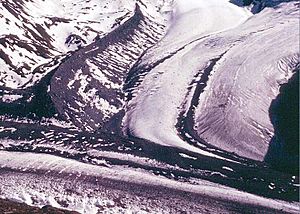Moraine facts for kids
Moraines are like natural piles of rocks, dirt, and other bits of material that are left behind by glaciers. Imagine a giant, slow-moving river of ice. As this ice moves, it scrapes and pushes everything in its path – from tiny grains of silt to huge boulders. When the glacier melts, all that stuff it carried gets dropped, forming these piles we call moraines. You can find moraines in places where glaciers exist today, or where they used to be a long, long time ago, like during an ice age.

Contents
What are Moraines?
Moraines are collections of debris (which means broken-up rocks and soil) that you find in areas with glaciers. These piles of material can be made of anything from very fine silt (like glacial flour) to large boulders.
How Do Moraines Form?
Glaciers are powerful forces that slowly move across the land. As they move, they pick up and carry a lot of material. This material can be scraped off the valley floor by the moving ice. It can also be rocks that have fallen off the valley walls due to weathering (like freezing and thawing).
When a glacier melts, it drops all the rocks and dirt it was carrying. This creates piles or sheets of debris. Moraines can be found right on the glacier's surface. They can also be left behind as hills or ridges where the glacier has completely melted away.
Sometimes, a glacier or a large piece of ice called an iceberg reaches the sea. When it melts in the water, it drops all the rocks it carried to the seafloor, forming underwater moraines.
Types of Moraines
There are different kinds of moraines, depending on where the material is deposited by the glacier:
- Lateral moraines form along the sides of a glacier. They look like ridges of rock and dirt running parallel to the glacier's path.
- Medial moraines form when two glaciers join together. The lateral moraines from each glacier combine in the middle, creating a single ridge of debris down the center of the new, larger glacier.
- Terminal moraines are found at the very end of a glacier. This is where the glacier stops moving forward and melts, dropping all its carried material in a large ridge. It marks the furthest point the glacier reached.
- Ground moraines are sheets of debris spread out under the glacier. When the glacier melts, this material is left behind, often creating an uneven, rolling landscape.
Moraines from the Past
Some moraines are found very far from any existing glaciers. These were created during past ice ages. During these times, huge ice sheets covered much of the Earth. As these ancient glaciers melted, they left behind massive moraines. These old moraines help scientists understand how far glaciers once spread.
Learn More
Images for kids
-
The snow-free debris hills around the lagoon are lateral and terminal moraines of a valley glacier in Nepal.
-
Medial moraines, Nuussuaq Peninsula, Greenland.
-
Moraine in Rocky Mountain National Park, taken by Ansel Adams in 1941.
-
Moraines around the Icy lake (2709 m), just below Musala peak (2925 m) in Rila Mountain, Bulgaria.
-
Moraine of Lake Garda.
See also
 In Spanish: Morrena para niños
In Spanish: Morrena para niños










